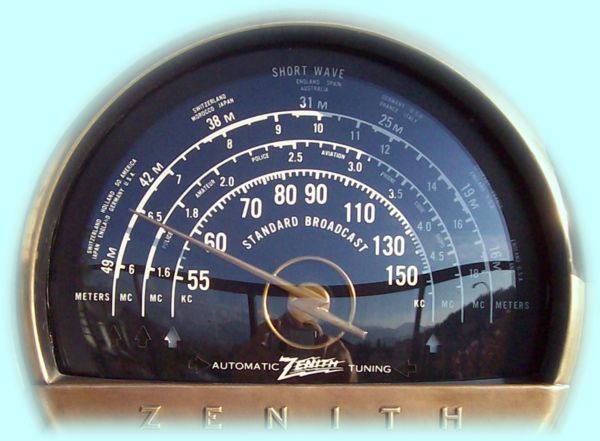Zenith's 1940/41 Black Dial Table-Top Radio Model 7S529 with 3-Loop SW Wave-Magnet Antenna, RadiOrgan and Automatic Tuning, with Original Faux-Burl Wood Nydoc Photo-Finish
In a Nutshell
Even not being a techie you may want to flip through the "techies" below to get a feeling what a successful restoration of this model involves - here it is - a phoenix from the ashes
 |
Introduction:
Zenith's 1940/41 7-tube table radio 7S529 had the same original price tag of $39.95 as the 6S330 tombstone radio also for sale here, a one week's average salary, or 5% of a car or 70 gallons of milk. It features a very efficient 3-loop wave-magnet antenna, the "RadiOrgan", a push-button fidelity tone control system, and a 6-button automatic tuning system. Restoration of these 1940's radios is challenging, to say the least. In modern terms a "recall" would have been issued, but Zenith let it to the service men to deal with some of the problems (pict.47 and "techies" below). As the 6S330 this radio has parts of the cabinet finished with a decal-like photo-finish, sometimes called Nydoc, which resembled an expensive exotic burl wood veneer. Many sets have been "restored" by
stripping and sanding the remaining flaking Nydoc away down to the
underlying (still quite nice looking though) regular wood veneer. My radio has the original factory faux burl Nydoc finish in almost mint condition. As the 6S330 this radio too has a highly decorative escutcheon with a two-tone bronze finish.
Zenith's 1939 RadiOrgan - Have the Music Your Way
- was advertized as "... an ingenious device, providing
through a series of six organ key-board tabs a choice of 64 tonal
combinations", "...the most original
and most exclusive tone improvement ever placed on a home radio". Try it yourself!
For the techies only:
As extraordinary and thus so collectable Zenith radios are, even Zeniths may have problems, especially in the line-up of their 1940 sets (6S527, 6S597, 7S343, 7S529, 7S557), that need to be addressed when attempting a successful and lasting restoration
1. the rubber wire problem
2. the 6X5 and the potted transformer problems
3. the NYDOC finish problem
ad 1.: Philco in 1939 and Zenith in 1940 started to replace cloth covered wiring with rubber insulated wiring. Today many of these sets have to be completely rewired (like this one), because the insulation is deteriorated, falling off and therefore dangerous (ref.2 and pict.35). A very time consuming but necessary procedure.
ad 2.: The rectifier tube 6X5, especially when used in combination with a 1940 Zenith potted transformer causes serious and well documented problems (ref.3 and pict.47). The radio for sale was not working anymore because a failing 6X5 had caused the transformer to partially melt-down. The tube has been replaced by a 5Y4 rectifier and the transformer restored by inserting a size-wise matching transformer with an additional 5V winding (heater for the new 5Y4), into the original shell (see insert Modifications in pict.50).
ad 3.: Zenith, as many other radio manufacturers, and starting already in the 1930's, for cost reasons used photo-finishes for all or parts of their cabinets, thus avoiding more expensive veneers. A very good example is the Zenith 6S330, also for sale. The 7S529 has two stripes of photo-finish on the top right and bottom left edges, that are often in such a bad condition, that the restorer has to sand them off completely and refinish the underlying regular veneer. My radio has both photo-finish stripes intact.
For the antennalogists only:
This radio has a very efficient loop antenna, introduced around 1940 by ZENITH as "Rotor Wavemagnet" for their high-end short-wave consoles. The antenna was in a box (pict. 40), and contained 3 nested multiturn coils, representing magnetic loop antennas, as opposed to a wire, telescope, or whip antenna. A slightly smaller version was used also in table radios, like this one (pict.s 41,42). A loop antenna (see ref.1) picks up only the magnetic component of the electromagnetic wave, whereas a dipole (whip) antenna also amplifies electric interference from street lights, cars, TV's, elevators and other low frequency generators. It is therefore the better choice in for example an apartment building. A multiturn loop antenna should have a total wire length L (that is the circumference of the loop times the number of turns) of about ¼ to ½ the wavelength λ = c/f of the incoming RF signal, where c is the speed of light and f the sender's frequency. Vice versa one can easily determine the short-wave bands accepted, from the mechanical dimensions of the loops, as follows:
| Coil |
Size["] |
Turns |
L["] |
f[MHz] |
SW Bands [m] |
| a. inner |
4½ Ø |
66 |
1050 |
2.8-5.6 MHz |
90 75 60 amateur 80 60 |
| b. middle |
6 x 13 |
13 |
494 |
6 - 14 MHz |
49 41 31 22 19 amateur 40 20 |
| c. outer |
7 x 2 |
2 x 5 |
180 |
16 - 32 MHz |
16 15 13 11 amateur 17 15 12 |
It thus turns out that the antenna is in fact sensitive to the full 30 MHz range of the short-wave spectrum.
Originally an extra wire antenna was hidden in the line cord. Since the cord has been replaced, the antenna had to be replaced too, by a contemporary long-wire AM antenna (pict.34).
Additional information:
ref. 1. http://www.aa5tb.com/loop.html#info
ref. 2 http://www.philcoradio.com/tech/wiring.htm
ref. 3 http://www.antiqueradios.com/forums/viewtopic.php?p=1034127
About my radio:
The radio is in almost mint condition, "almost" because parts of the cabinet have been refinished, but without touching the original Nydoc-finished stripes. The radio has been completely rewired and the power supply (transformer and rectifier) restored (see techies). In many long hours of work the delicate push-button preset station mechanics and electronics were restored (pict.33) and the RadiOrgan checked. The speaker grille cloth has been replaced (pict.11), but the original (pict.46) will be included if wanted. The radio exhibits its original back plane (pict.16), with a dealers tag on it: R.C. Hirdler Co., 3603 Bryant Avenue South, (Minneapolis MN). Also a rare Zenith tab with model number (7S529) and original price tag ($39.95) is still attached to the back plane (pict.43).
The reception is excellent on all 3 bands (yes, even SW stations could be tuned in. A long wire is needed at the antenna connector, mainly for AM/BC (pict.34 and antennalogists above). Presetting stations can be done from the front side by removing an extra piece of brass (pict.25). The radio does not hum and has a warm (tone-controlled) bass response due to the large 6" speaker and the solid wood construction of the cabinet. All moveable parts were treated with contact spray (especially the push-button contacts). Please
e-mail me (Kris) for any questions, ich spreche Deutsch, je parle Français.
Here are the specifications:
Technical Description of Item |
| Manufacturer |
ZENITH Radio Corp. Chicago USA |
| Model |
7S529 |
| Chassis |
7A02 |
| Production Year |
1940/41 |
| Serial Number |
S 920988 |
| Type |
7-tube 3-Band (AM/BC + 2 x SW) Superheterodyne Receiver |
| Cabinet |
Veneered wood with Nydoc photo-finish stripes |
| Knobs |
2 (3) original Zenith white plastic lightning bolt knobs |
| Dial |
Zenith Black Dial w. 2 pilot lights, brass escutcheon with crystal glass lens |
| Frequency Range |
AM/BC 550-1500 kHz, SW1 1.6-4.7 MHz, SW2 6-18 MHz |
| Tube Lineup |
1232(RF), 7B8(Conv.), 7A7(IF), 7A4(Det.), 7B4(AF1), 6F6(AF2), 5Y4(Rect.) |
| Size (WxDxH) |
16" x 10½" (incl. knobs) x 9½" |
| Weight |
7.8 kg = 17 pounds |
| Comment |
1940 high-end Zenith Black Dial short-wave radio, totally restored and serviced, Collector's dream |
|




